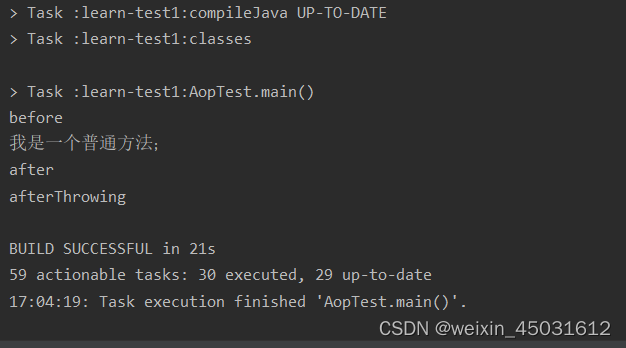文章导航
Spring AOP:基本概述
Spring AOP源码:配置文件解析过程
Spring AOP源码:配置文件解析过程
Spring AOP源码:拦截器责任链处理过程
前言
AOP在我们日常的开发种用得比较多,如最常见的事务。当我们需要对某些包下面的类的方法执行前后增加某些功能时,就可以使用AOP技术来实现,常见的有xml配置的方法、注解的方式(用的比较多)。Spring AOP 底层使用Cglib和JDK动态代理的方式进行实现,在前面的文章种已经讲解了这两种代码方式。
概述
什么是AOP
(1)面向切面编程(方面),利用AOP可以对业务逻辑的各个部分进行隔离,从而是的业务逻辑各部分之间的耦合度降低,提高程序的可重用性,同时提高了开发的效率。
(2)通俗描述:不通过修改源代码方式,在主干功能里面添加新功能

AOP常见名词
Aspect(切面): Aspect 声明类似于 Java 中的类声明,在 Aspect 中会包含着一些 Pointcut 以及相应的 Advice。
Joint point(连接点):表示在程序中明确定义的点,典型的包括方法调用,对类成员的访问以及异常处理程序块的执行等等,它自身还可以嵌套其它 joint point。
Pointcut(切点):表示一组 joint point,这些 joint point 或是通过逻辑关系组合起来,或是通过通配、正则表达式等方式集中起来,它定义了相应的 Advice 将要发生的地方。
Advice(增强):Advice 定义了在 Pointcut 里面定义的程序点具体要做的操作,它通过 before、after 和 around 来区别是在每个 joint point 之前、之后还是代替执行的代码。
Target(目标对象):织入 Advice 的目标对象.。
Weaving(织入):将 Aspect 和其他对象连接起来, 并创建 Adviced object 的过程
案例
通过案例的方案让我们更加清晰的了解Spring AOP的使用。
编写切面类
package aop.service;
public class MyAspect {
public void before(){
System.out.println("before");
}
public void after(){
System.out.println("after");
}
public void afterThrowing(){
System.out.println("afterThrowing");
}
public void afterReturn(){
System.out.println("afterReturn");
}
public void around(){
System.out.println("around");
}
}
编写目标类
public class MyClass {
public void myMethod(){
System.out.println("我是一个普通方法;");
}
}
编写配置
<?xml version="1.0" encoding="UTF-8"?>
<beans xmlns="http://www.springframework.org/schema/beans"
xmlns:xsi="http://www.w3.org/2001/XMLSchema-instance"
xmlns:aop="http://www.springframework.org/schema/aop"
xsi:schemaLocation="http://www.springframework.org/schema/beans
http://www.springframework.org/schema/beans/spring-beans.xsd
http://www.springframework.org/schema/aop
http://www.springframework.org/schema/aop/spring-aop.xsd">
<bean class="aop.test.MyClass" id="myClass"></bean>
<bean class="aop.service.MyAspect" id="myAspect"></bean>
<aop:config>
<aop:pointcut id="myPointCut" expression="execution(* aop.test.*.*())"/>
<aop:aspect ref="myAspect">
<aop:before method="before" pointcut-ref="myPointCut"></aop:before>
<aop:after method="after" pointcut-ref="myPointCut"></aop:after>
<aop:after-returning method="afterThrowing" pointcut-ref="myPointCut"></aop:after-returning>
<aop:after-throwing method="afterThrowing" pointcut-ref="myPointCut"></aop:after-throwing>
</aop:aspect>
</aop:config>
</beans>
编写测试用例
public class AopTest {
public static void main(String[] args) {
ClassPathXmlApplicationContext context=new ClassPathXmlApplicationContext("application-aop.xml");
MyClass myClass = (MyClass) context.getBean("myClass");
myClass.myMethod();
}
}
